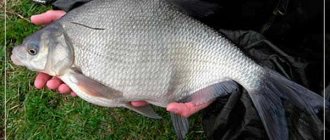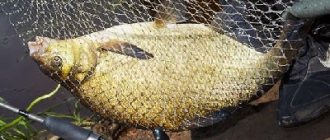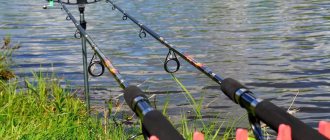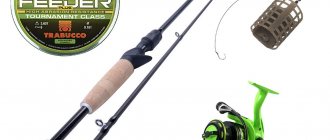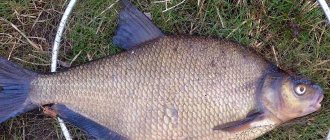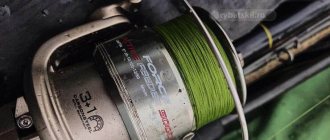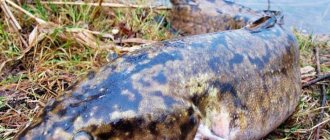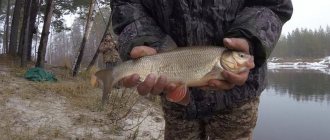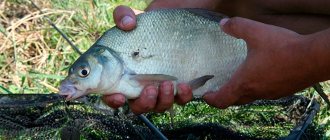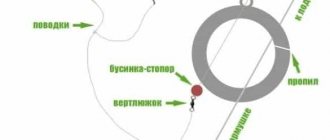Among fishermen, bream fishing is considered a very professional fishing, such fishermen are called bream fishermen, they are engaged in purposefully catching trophy specimens from spring, summer and until late autumn, with short breaks, and many achieve real virtuosity in this. And also many fishing enthusiasts prefer to catch bream using a feeder and other bottom gear, both from the shore and from a boat in a river or in the calm water of a lake or bay. But despite the fact that there is quite a lot of this fish in our reservoirs, we should not forget that there is a ban on catching bream during the spawning period, so that there will continue to be a lot of this fish in our rivers, lakes and bays.
Where to catch bream on a feeder
To choose a place to catch bream on a feeder or bottom, you need to know where bream schools live, when and what they feed on. These fish avoid fast currents and stick to calm waters. In addition, this is a cautious fish and chooses deep places for its permanent residence. It is correct to catch them where they live permanently, and not where they go for walks, since this fish is very lazy and comes out of the pits inconsistently and only when there is a lack of food or when the weather changes.
And if you managed to find a place for bream, then when catching bream on a feeder or bottom, it is always better to use feeders with bait. It’s also better to feed the fishing spot in advance; it happens that sometimes you have to feed for several days in one place, but the probability of catching a trophy specimen will be much greater than without bait.
This fish can be caught during the day, but not often; when fishing during the day, you need to take into account the position of the sun. If you catch it from a boat, then you need to stand on the boat and stay so that the sun is in front or to the side, but not behind, so that the shadow does not fall on the fishing spot, since the fish is very careful and does not come close to the shadow.
However, in the spring on the river, when schools of bream are walking, they are sometimes caught in not very deep places with a flat sandy bottom, and of course with bait. The largest individuals are usually found near steep clayey shores in holes and pools. In general, this fish needs to be looked for, and if the fishing spot is not known to the fisherman thoroughly with its depths, then it is better to use an echo sounder, more to determine the depths than to search for fish.
However, after spawning in late spring and early summer, bream usually bites on the feeder in the morning, but not in the very early morning, but from 6-7 am. And when the grass is already growing, they take large specimens only early in the morning, before sunrise, and also peck at sunset, very late in the dark. It’s better to catch them on quiet and warm nights and especially during the full moon.
In summer, the phases of the moon greatly influence the lifestyle of these fish; it is noticed that the bite also stops when the new moon appears. Probably during the new moon and the first quarter, the fish come out of the holes in the shallows and catching bream on a feeder in holes and pools is less successful, and it is better to try to catch bream with a float rod or bottom tackle in shallow places.
Bream, like many other fish, are sensitive to changes in atmospheric pressure. Before bad weather, the barometer pressure drops, and they completely stop being caught with a fishing rod, feeder or donk, because they lie in holes and even bury themselves in silt. And also these fish stop catching when the northeast or north wind blows. The water level also affects the fish’s bite; they only take in low and medium water, but in the profit of water, after heavy rain, and during floods, in the summer bream on the feeder not only stop being caught, but even temporarily leave their holes. When the water recedes, they return to their summer camps.
In the heat of summer, before a thunderstorm, as well as on cloudy and windy days, they rise to the top, only to then hide in the depths again. Rising from the depths, the fish first sticks its muzzle out of the water, then its dorsal fin, and then its tail, which it throws to the side sometimes with a splash. This also happens in shallows, but more at night. Usually in rivers in aquatic thickets, schools of bream can be identified by the loud swishing or smacking sounds made by their mouths, so they suck on the upper, young shoots of plants, as well as the roots of duckweed.
Fishing for bream on a feeder or donka in open water begins in early spring in April, as soon as the ice melts and in May. But the early spring bite in May before spawning is short-lived, although fish that have become hungry during the winter take very well, and fishing can be very productive. After spawning, having eaten enough, they stop taking fish for a month or more, sometimes getting caught on windy, cloudy or thundery days.
Bream begin to bite on the feeder in the summer from mid-July, and in the north already in August, when they already begin to flock into herds and you can catch them very successfully during August and September if you know the fishing spots, sometimes even in larger quantities than you can catch after spawning
Bream fishing in the fall is not known to all fishermen, and some of them even think that this fish is not caught at all in the fall. And yet, during the autumn bream feast, when the water is already beginning to cool down after summer, schools of bream go to shallow depths and fatten, scattering from their holes and deep camps. Usually in the fall this happens after sunset at night not far from the shore in reed thickets, where you can catch them in abundance if you don’t make any noises that frighten the fish.
Where to catch silver bream
Despite the fact that in the evening hours the silver bream tends to come close to the shore, it still prefers to stick to the depths. And the weaker the current, the greater the depth of its location. Therefore, for fishing it is better to select places where the depth is close to the shore. Medium-sized rivers are the most convenient for fishing, since large and wide bodies of water often have problems finding a suitable place. Large silver bream enters small rivers extremely rarely, only if the depth allows.
Promising and convenient for fishing are rivers that flow into flowing reservoirs. For example, tributaries of the Volga. Of the rivers near Moscow, the most interesting are the Volga, Oka, Nerl Volzhskaya, and the lower reaches of the Dubna.
250 kg of fish for 1 fishing trip
The detained poachers told the secret of their success for a good bite. The fisheries inspectors were so surprised by their lack of poaching equipment.
The spring pre-spawning “washing” of the silver bream is somewhat reminiscent of the movement of the roach, but the silver bream does not rise as high as the roach or ide, and does not go out into shallow water. Its progress is usually limited to a certain depth on the river bed. The gustera rises until the depth becomes, for example, 3 m, and goes no further. For a large silver bream, this limit can be 4–6 m. Small silver bream rises much higher, and some fish remain in the river throughout the summer.
The water temperature is of great importance for the white bream: in order for the eggs to develop, it must be at least +16°C.
When choosing a fishing spot, you should pay attention to sandy and pebble shores. It is very good if such an area is located near the core of the current, and there is a depression with a smooth, weak current near the shore. Very good places are located behind underwater spits, as well as deep areas on the border of current and standing water.
The largest specimens can sometimes be found in deep irrigation in the immediate vicinity of the bank edge (this is typical for canals), as well as at the mouth of a tributary channel or at the exit of an underwater ditch.
This fish, as a rule, avoids silted areas. This is due to the fact that the main food for large silver bream is not bloodworms, but aquatic worms and zebra mussels.
The right feeder for bream
Donka is any bottom tackle that is used to catch fish from the bottom, be it fishing for bream with a ring or fishing with an elastic band, or just a bait wound on a reel or other types of tackle. But usually when fishing from the shore, a feeder rod or spinning rod is used to cast a donkey.
Catching bream on a feeder or bottom is practiced both in the flow of a river and in the calm water of a lake or bay. During the day they are rarely caught with donka, mainly in the evening, at night or early in the morning. You can fish with feeder gear from the shore or from a boat. But it’s better to fish from a boat in the current, so that the line is stretched even when the boat sways slightly in the wave or wind. And when fishing from a boat, the length of the feeder rod should be significantly less than the feeder for catching bream from the shore.
It is better to take a longer feeder for catching bream from the shore, so that you can cast it far. The best type of feeder rod would be 3.0-4.2 meters long, and it should be very durable, so that it can also be equipped with a sinker with a feeder. Typically, a feeder rod for fishing on the current and from the shore is best used with a test weight of 60-120 grams. These feeder rods are usually sold with a set of two or three interchangeable tips with different flexibility to accommodate different weights of the feeder sinker.
This is convenient because when fishing for bream on a feeder in calm water, a sinker weighing 30-60 grams is enough for the equipment and, accordingly, the necessary tip is placed under this weight. And if you fish in a river current, then you need a larger sinker, weighing 60-120 grams, depending on the strength of the current, and you need a more powerful tip. And at the same time, which is very important, the sensitivity of the tips will show the subtlest bite. In the equipment of such a feeder, a bell or bells and even a spring nod will be superfluous, because a bite will be immediately visible at the tip of the feeder.
And for catching bream from a boat, the most common fishing rod is suitable, even your grandfather’s old aluminum spinning rod or a budget but durable rod 1.0-2.1 meters long, short enough to be easily handled in a boat.
Feeder equipment for bream
To equip a feeder rod for catching bream from a boat, a very simple inertial reel similar to the old proven Neva reel is suitable. Since you don’t need to cast very far from the boat, there are fewer requirements for the reel. It is better to wind a thick fishing line, with a diameter of 0.30-0.45 mm and a length of 50-60 meters is enough.
To signal a bite, many fishermen use bells or bells in their feeder or donkey equipment. Such equipment immediately indicates the inexperience of the fisherman, since when fishing on a boat during a wave or at the moment of any movements and movements of the fisherman in the boat, these ringing alarms immediately begin to ring, and even irritate fishermen on neighboring boats. To properly equip a feeder for a boat, it is better to use a spring nod with a bright ball so that it can be seen even at dusk. Such a nod cannot be heard, but is visible, which is why you need to watch for the nod when fishing, and not sleep in the boat.
To catch bream on a feeder from the shore with a reel, for long-distance casting you need a more technologically advanced one, you need a durable and high-quality spinning reel of size 2500 -4000 with a spool that can accommodate a fishing line with a diameter of 0.3-0.4 mm and a length of 100 meters. A multiplier casting reel is also suitable. But a good baitcasting reel that will not create problems with fishing line beards costs good money and will require the fisherman to have the skills to use such a reel.
To equip the bottom of the feeder, a feeder with a weight and one hook or two, sometimes three hooks on leashes made of fishing line are usually used. It is imperative that the hooks do not get tangled with the main line, and are at a distance of 20-40 cm from it. Some fishermen tie the hook on a leash after the sinker-feeder with bream bait, and others before the sinker on the main line, and there are also combined options. It is more likely that the first version of the feeder rig is more catchy and correct, since the leash with the hook will definitely not get tangled with the main fishing line and the bait is guaranteed to be on the bottom.
To use feeder gear with leashes above the sinker, fishing stores sell a large variety of different devices, diverter leashes, jumpers and rocker arms made of wire and plastic. In order for the line leashes with hooks to be away from the main line and not tangled with the main line when casting, but the hooks would be located next to the feeder.
The leash from the fishing line for the hook should be taken thinner than the main fishing line, with a cross-section of 0.16-0.22 mm and made of such a length that, having thrown the feeder tackle into the water, the hook with bait would lie at the bottom and in close proximity to the feeder sinker. For proper feeder fishing of bream, the hook with bait must be at the bottom or at the very bottom, because a large bream sucks the bait from the bottom with its lips, pulling them into a small trunk, and while suspended in the water, a bream or other white fish can take the bait.
It is better to tie hooks for feeder tackle for bream, they must be of high quality and very sharp, hook number 7-12 (according to Russian numbering) with a long shank so that a bunch of worms can be attached to it. It will be difficult to attract a good and large bream with just one worm; he likes it when there is plenty of bait on the hook.
Fishing for bream in August on a feeder
Bream is the main synonym for feeder fishing, because it is for catching this fish that the latest techniques and tactics for feeding places, devices and a huge amount of gear have been developed.
It is in August, when the nights become longer and the water temperature constantly changes, that the time comes to catch large individuals of this species.
In the last month of summer, an amazing time begins - fish flock together and feed intensively, and the process takes place in classic places with shallow depths, which gives every fisherman a great chance to catch the fish he dreamed of.
Choosing a fishing spot for catching bream in August
Promising places are straight river runs, where a smooth current prevails and which are formed at the exit from the pits.
In general, such places are a real paradise for fishing, because a huge amount of fish accumulates in them, not only bream, but also other representatives.
Exits to pits are also excellent for catching bream, since in such places a huge amount of food accumulates, which attracts fish.
In such places, the bottom is characterized by a broken topography with complex jets, which is especially to the taste of fish.
Effective catches can also be found in still waters with little rip current. In such places, a fairly large depth is formed and many large individuals are always present.
Also a good place for fishing are the oxbow lakes adjacent to the river. In most cases, such reservoirs are not deep and therefore warm up well, due to which there is a large growth of microorganisms in them, which is what the fish feed on.
If we talk about lake fishing, it should be noted that finding a place in a lake where a large number of fish accumulates is very problematic, with the exception of cases of coastal fishing.
Bream prefers to go out to water bodies in search of food, and if their depth reaches no more than two meters, then the fisherman’s chances of catching a large representative increase significantly.
Selection of gear for catching bream in August
Large bream is a fairly lively fish, which affects the choice of gear. When choosing, it is important to pay attention to the performance characteristics of gear, because if you do not show due attention and responsibility, fishing may not end up looking promising.
So, for example, when starting to choose a fishing rod, you need to choose models that reach a length of about 3.6-3.9 meters.
With such rods it is much more convenient and freer to make long casts, especially at night, when visibility conditions for the object are significantly deteriorated.
The choice of reel depends on the preferences of the fisherman; it is only worth noting that the most advisable is to buy a reel whose size is at least 4000.
A difficult choice must be made between buying a braided cord or a regular fishing line.
So, for fishing at a distance of up to 25 meters, a regular fishing line is suitable, since its excessive stretchability will not have a negative impact on the fishing process.
If you plan to fish at a distance of more than 25 meters, then it is best to give preference to a braided cord, but the diameter should be chosen as small as possible.
The length of the leash also plays an important role, so you need to choose it carefully and thoughtfully.
Bait for catching bream in August
Of course, it is impossible to imagine successful bream fishing in August without the use of effective bait, on which the effectiveness of the bite depends.
If a fisherman has a trusted store that sells high-quality bait from the manufacturer, and he does not have time to prepare the mixture, then he can choose ready-made packages.
If you have time to prepare, then it is best to complete the entire process yourself.
When purchasing ready-made bait, you need to take into account the main criteria:
- type and size of fish;
- type of reservoir;
- method of fishing.
If you plan to prepare bait with your own hands, then you need to take into account all the rules.
So the mixture should not only attract fish, but also keep them for a while.
To attract a flock, you need to prepare bait from the following ingredients:
- breadcrumbs;
- wheat bran;
- ground biscuits;
- corn flour and grits;
- oatmeal or crushed rolled oats;
- roasted and ground sunflower seeds.
Mixing such ingredients is not enough, because you need to moisten the mixture and leave it to steep for 20-30 minutes and then check how it disintegrates in water.
Baits for catching bream
The last month of summer is a kind of stage when fish switches from plant foods to animal foods and is in constant search of food.
Since bream is a rather finicky fish, you need to take a whole arsenal of various attachments and baits with you when fishing so that the fishing is truly effective and your time near the reservoir is not wasted.
I have been active fishing for quite some time and have found many ways to improve the bite. And here are the most effective:
- Bite activator. Attracts fish in cold and warm water with the help of pheromones included in the composition and stimulates its appetite. It’s a pity that Rosprirodnadzor wants to impose a ban on its sale.
- More sensitive gear. Reviews and instructions for other types of gear can be found on the pages of my website.
- Lures using pheromones.
You can get the rest of the secrets of successful fishing for free by reading my other materials on the site.
To retain bream you need to use the following animal baits:
- bloodworm;
- chopped worms;
- maggot;
- steamed peas;
- canned corn;
- boiled pearl barley porridge;
- semolina chatter.
There are situations when a fisherman baits a spot for several hours, but for unknown reasons the mixture does not attract bream and then the fisherman needs to take a non-standard approach.
You need to use a combination of baits on the hook, for example, you can make a delicious sandwich from maggot and peas, pearl barley and a worm, bloodworms and corn.
If this method does not attract bream, you can try combining two seemingly inedible components: polystyrene foam balls and pieces of scented foam rubber.
Of course, at first glance this combination does not seem promising, but in practice the result is completely opposite.
The method of fishing for bream using boilie carp bait has also proven itself to be very effective.
Catching bream on a feeder - features
A feeder is a special fishing rod that resembles a donka known throughout the fishing world, but significantly modernized.
A special feature of the feeder is its lightness, ease of use and efficiency.
In addition, fishing in this way is also available to those who set out to “get” fish for the first time.
Another feature is the all-season nature of the method - you can fish as soon as the ice melts and until it covers the river again.
Properly chosen fishing gear is the key to successful fishing.
So, the best length of a feeder rod is 3 meters, and the reel is at least 3000 powerful, strong and spacious.
In addition, you need to choose other components correctly, for example, the length of the fishing line should be 100-1500 meters, the diameter should be 0.3 millimeters.
A special feature of catching bream on a feeder is the method of feeding it. A certain rule applies here: what the baiting process is for is why you need to catch bream, for example, if maggot is added to the bait, it needs to be put on the hook.
Since bream feed in pit-like places, it is more effective to throw bait above the place where it presumably lives.
Fishing with a feeder - which feeder to choose?
The choice of feeder is key
Since bream feed in pit-like places, it is more effective to throw bait above the place where it presumably lives.
role, because it is important to choose a high-quality, comfortable and durable model that will ensure successful fishing and will not force the fisherman to sit by the pond for a long time in vain.
There are many models of modern feeders, and choosing just one is not difficult; you just need to look through the review and choose the best model.
You should also pay attention not only to the cost of the feeder, but also to the manufacturer and features.
Review of the best feeders and their features
There are a huge number of feeder models, but among all the models there is a top of the best, which have proven themselves with their excellent performance qualities.
Mikado feeders
This feeder is in demand among fishermen due to its good performance and relatively low price. On the positive side, models whose length reaches up to 3.6 m have proven themselves.
MikadoTwinFeeder models work well; MikadoEverGreenUltraHeavy; Mikado Matrix 777.
Feeders Salmo
The Baltic company Salmo has been producing products for fishing for more than twenty years.
The models produced differ not only in price category, but also in quality.
The most expensive models are: SalmoElite; SalmoDiamond. Budget options include models: SalmoSupreme; SalmoTaifun.
Banax Piccolo feeders
A series of such feeder rods was developed taking into account the characteristics of Russian reservoirs. Such models are equipped with an insert knee, with the help of which the length of the fishing rod can be increased by 50 cm.
Daiwa feeders
If you plan to fish in deep waters, then it is best to pay attention to the DaiwaAqualiteHeavyFeeder.
For professional fishermen, Japanese engineers have released a series of DaiwaTournament F-1 Feeder rods. Such Japanese feeders are distinguished by their lightness, quality, durability and convenience.
Tips for beginners on choosing a feeder
When choosing a feeder, you need to pay attention to:
- feeder rod length;
- tops or as they are also called quivertips;
- feeder rod test;
- rod action;
- accessories.
Feeder fishing is gaining more and more popularity every year, which is why you should start planning your fishing properly, choosing the right components and effective lures and baits.
I caught this pike using a bite activator. No more fishing without a catch and no more looking for excuses for your bad luck! It's time to change everything!!! The best bite activator of the year! Made in Italy…
MORE DETAILS
superkaras.ru
Bream baits and baits for donka
The bait on the hook for catching bream on a feeder or bottom is relatively monotonous, mainly red dung worms and crawlers, and many more are caught on bread balls, peas or corn. The choice of bait depends on where you are fishing and the preferences of the fish in those areas. Crawlers, large earthworms such as worms, burrs and others are caught mainly at night in the current, because the bite on this bait is not always successful, and there are frequent misses when hooking.
When fishing with dung worms, you must take into account that the more of them on the hook, the better. That's right, when the worms are pricked on the hook in two places, the first puncture is below the head, the second near the middle, intertwining their tails, the worms form a compact and appetizing lump that attracts fish. There are other animal baits for bream, such as molting crayfish, broom or honeydew, maggot and rat - the larva of a large green fly, and sometimes bloodworms.
Sometimes steamed peas serve very well as bait for bream and white bream, and so that they do not fall apart and fall off the hook, it is better to cook them correctly. Having chosen large peas from the latest harvest, pour them into a bag so that it takes up one third, and fill with water, soak the peas for 6-8 hours. Next, cook over low heat for 1.5-2 hours, and then drain the water, and then roll the peas in salted butter.
Bream bite on feeder tackle
The bream bites quietly and carefully on the feeder; sometimes the bite may not be noticed; only long-term practice of fishing on the feeder will indicate the moment of hooking. In a river with a weak current, it is better to hook when the stretched line begins to sway, that is, weakens, and then tightens. When fishing in the current, usually the bream bite is different; taking the bait into the mouth, the fish moves further, against the current, weakening the line, and the hook will no longer be so accurate and therefore must be quite strong and sharp.
Bream is sensitive to pain and goes stunned when hooked, and at the first moment a large bream after hooking creates a feeling of being hooked, then it seems to faint. And then, lying down on one side or the other, it obediently goes to the surface. Having described several circles, the fish floats to the top like a board.
When fishing from a boat, experienced fishermen pull out the caught feeder bream by the eye sockets before it has time to wake up from its fainting state. They put it in a cage and lower it deeper into the water, tying the cage well. Some fishermen, having cut the fish into the cerebellum, place it on straw in the boat so that it does not hit the bottom of the boat and create noise.
Fishing for silver bream in summer
Summer fishing starts immediately after spawning, in June. As the water warms, the fish rise to the surface of the water. You can catch it with a fishing rod. There is a peculiarity that different flocks of silver bream feed at different times. One came, ate the bait, several individuals moved into the cage, and after a while a second flock came up behind it. This can continue throughout the day.
On hot days, the silver bream stays in the bottom layers. In the pre-dawn hours, she often visits the coastal zone. Fishing with a lapdog is most effective at this time.
When fishing with a feeder, it is better to find the boundary between shell and sand. A rocky bottom is also suitable; a muddy bottom is not suitable. The silver bream should be fed in the same way as bream. She loves to eat well. But she is not picky about food, so the feeders are filled with millet and breadcrumbs plus some store-bought bait. We use hook No. 14 -12. In mid-summer, the white bream bite intensifies after a little warm rain. It should be caught in places rich in oxygen. Places with depths from 3 to 5 meters are considered promising.
What does the silver bream bite on in June, July and August?
Several maggots, a red worm, pearl barley, and dough with the smells of honey, vanilla and anise are placed on the hooks. Steamed wheat grains, star pasta, airy flavored dough, and toasted bread cubes work well.
Go to the summer fishing
to get acquainted with fishing for other types of fish during this period.
